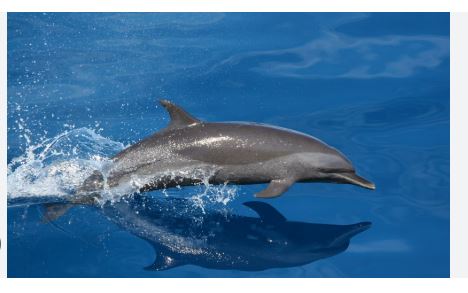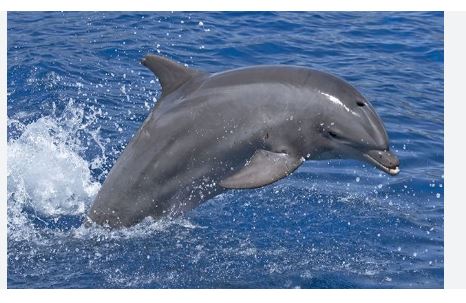
Dolphins are remarkable marine mammals belonging primarily to the family Delphinidae, with a few exceptions in other families like Orcaellidae. Known scientifically as cetaceans, they share a lineage with whales and porpoises but stand out for their intelligence, social behavior, and agility. Over 40 species exist, ranging from the massive orca to the tiny Hector’s dolphin, and they inhabit oceans, rivers, and estuaries worldwide. Their streamlined bodies, dorsal fins, and powerful tails make them exceptional swimmers, while their playful nature—leaping, spinning, and bow-riding—has endeared them to humans for centuries.
Physically, dolphins vary widely but share key traits. Most have a fusiform (tapered) body, a beak-like rostrum (though some lack it), and a blowhole atop their heads for breathing. Their skin is smooth and rubbery, often gray, though species like the Commerson’s dolphin sport striking black-and-white patterns, and the Indo-Pacific humpbacked dolphin can appear pink. Dolphins use echolocation—a sophisticated sonar system—to navigate and hunt, emitting clicks that bounce off objects. Their diet is carnivorous, typically fish, squid, and crustaceans, with hunting strategies varying from solo pursuits to coordinated pod efforts, as seen in orcas.
Socially, dolphins are among the most complex animals. They live in pods that can range from a few individuals to hundreds, depending on the species and environment. These groups are often structured, with strong bonds between mothers and calves, and some species, like the short-finned pilot whale, form matriarchal societies. Communication is rich, involving whistles, clicks, and body language—each dolphin may even have a unique “signature whistle” akin to a name. This social intelligence, paired with problem-solving skills (like using sponges to protect their snouts while foraging), suggests a level of cognition rivaling primates.
Dolphins face numerous challenges in the modern world, despite their adaptability. Coastal species like the Guiana dolphin suffer from habitat degradation due to pollution and development, while others, such as Hector’s dolphin, are endangered by fishing nets. Climate change affects prey availability, and human interactions—both positive (tourism) and negative (bycatch)—impact their populations. Yet, their resilience shines through, with some species thriving in protected areas. Dolphins remain a symbol of the ocean’s wonder, blending grace, intellect, and mystery in a way few creatures can match.

Types of Dolphins
Bottlenose Dolphin (Tursiops truncatus)
Perhaps the most famous dolphin, thanks to shows like Flipper, bottlenose dolphins are large, gray, and have a distinctive short, stubby beak. They’re found in warm and temperate seas globally, often near coasts. They’re highly social, living in pods, and known for their acrobatic leaps and complex vocalizations.
Common Dolphin (Delphinus delphis)
Recognizable by their hourglass pattern—yellowish-tan on the sides and dark gray on the back—these dolphins are fast swimmers. They inhabit warm and tropical waters worldwide and are often seen in large groups, sometimes numbering in the hundreds, bow-riding alongside boats.
Spinner Dolphin (Stenella longirostris)
Named for their spectacular spinning leaps, spinner dolphins are smaller and slender, with a long, thin beak. They’re found in tropical oceans, often resting in shallow bays during the day and feeding offshore at night. Their acrobatics might serve as communication or just pure fun.
Pacific White-Sided Dolphin (Lagenorhynchus obliquidens)
These dolphins have a striking black, white, and gray color scheme and a short beak. They thrive in the cool waters of the North Pacific, from Japan to North America. They’re energetic, often seen leaping and somersaulting in tight-knit groups.
Atlantic Spotted Dolphin (Stenella frontalis)
Covered in spots that increase with age, these dolphins start life gray and gradually become speckled. They’re found in the warm Atlantic, especially around the Gulf Stream. They’re playful and often approach boats, making them a favorite for dolphin-watchers.
Risso’s Dolphin (Grampus griseus)
With a blunt head and no distinct beak, Risso’s dolphins stand out due to their heavily scarred, grayish-white bodies—scars often from squid They live in deep offshore waters worldwide. Their diet includes squid, which might explain their preference for deeper habitats.
Hector’s Dolphin (Cephalorhynchus hectori)
One of the smallest dolphins, Hector’s is endemic to New Zealand’s coastal waters. They’re tiny (about 4-5 feet long) with rounded dorsal fins and a gray-black-white pattern. Sadly, they’re endangered due to fishing net entanglements.
Orca (Orcinus orca)
Technically the largest dolphin species, orcas (killer whales) are apex predators with bold black-and-white markings. Found in all oceans, they hunt everything from fish to seals in highly coordinated pods. Their intelligence and social structure are legendary.
Striped Dolphin (Stenella coeruleoalba)
These dolphins have blue and white stripes along their sides, giving them a sleek, painted look. They prefer deep, warm waters far from shore and are known for their agility, often leaping high out of the water in tropical and subtropical regions.
Fraser’s Dolphin (Lagenodelphis hosei)
A lesser-known species, Fraser’s dolphins have a stocky build and a short beak. They’re found in deep tropical waters, often in large groups. They’re elusive, making sightings rare, but they’re known to swim closely together in tight formations.
Dusky Dolphin (Lagenorhynchus obscurus)
Native to the Southern Hemisphere, particularly around New Zealand and South America, dusky dolphins are small and dark with a sloping forehead. They’re acrobatic, performing flips and twists, possibly to herd fish or communicate.
Hourglass Dolphin (Lagenorhynchus cruciger)
Named for the hourglass-shaped white patches on their sides, these rare dolphins live in the cold waters of the Southern Ocean near Antarctica. They’re small, fast, and often seen riding waves near ships, though their remote habitat keeps them mysterious.
Rough-Toothed Dolphin (Steno bredanensis)
Named for the subtle ridges on their teeth, these dolphins have a long, slender beak and a slightly reptilian look. They’re found in deep, warm waters worldwide, often in small groups. They’re known to eat large fish and even mahi-mahi, showing their strength despite a lean build.
Pantropical Spotted Dolphin (Stenella attenuata)
Similar to the Atlantic spotted dolphin but slimmer, these dolphins develop spots with age and live in tropical waters across all major oceans. They’re social and often mingle with other species like spinner dolphins, forming massive mixed pods.
Clymene Dolphin (Stenella clymene)
A hybrid-looking species (sometimes called a “short-snouted spinner”), Clymene dolphins have a mix of gray tones and a short beak. Found in the Atlantic’s warm waters, they’re known for spinning, though less dramatically than their spinner cousins.
White-Beaked Dolphin (Lagenorhynchus albirostris)
With a white or pale beak and robust body, these dolphins inhabit the cold North Atlantic, from Canada to Norway. They’re strong swimmers, often seen in small groups, and feed on fish like cod and herring in chilly waters.
Peale’s Dolphin (Lagenorhynchus australis)
Also called the black-chinned dolphin, Peale’s has a dark face and white patches on its sides. They’re found in the coastal waters of southern South America, especially around the Falkland Islands, where they navigate kelp forests with ease.
Northern Right Whale Dolphin (Lissodelphis borealis)
Unique for lacking a dorsal fin, this sleek, black-and-white dolphin lives in the North Pacific’s deep, cool waters. Their streamlined shape helps them glide effortlessly, and they’re often seen in large, synchronized groups.
Southern Right Whale Dolphin (Lissodelphis peronii)
The southern counterpart to the northern species, these finless dolphins roam the Southern Ocean’s cold currents. They’re similarly slender and black-and-white, with a graceful, almost whale-like appearance, and prefer open seas.
Irrawaddy Dolphin (Orcaella brevirostris)
Not a true oceanic dolphin (it’s in the family Orcaellidae), this species has a rounded head, no beak, and a small dorsal fin. Found in Southeast Asian rivers, estuaries, and coastal waters, they’re shy and known for spitting water, possibly to herd fish.
Australian Snubfin Dolphin (Orcaella heinsohni)
Closely related to the Irrawaddy, this species has a blunt head and lives in northern Australia’s shallow coastal waters. Discovered as a distinct species in 2005, they’re rare and elusive, with a stubby dorsal fin and a preference for murky habitats.
Commerson’s Dolphin (Cephalorhynchus commersonii)
Nicknamed the “panda dolphin” for its bold black-and-white pattern, this small species has a rounded body and no beak. They live in two populations: one off South America and another near the Kerguelen Islands in the Indian Ocean, thriving in cold, shallow waters.
Chilean Dolphin (Cephalorhynchus eutropia)
Another small, coastal species, Chilean dolphins are gray with subtle markings and a rounded dorsal fin. Found only along Chile’s rugged coast, they’re secretive and often swim in small groups near kelp beds, making them hard to spot.
Long-Finned Pilot Whale (Globicephala melas)
Though called a whale, this is a large dolphin species with a bulbous forehead and long, sickle-shaped flippers. They inhabit cold and temperate waters, like the North Atlantic and Southern Ocean, living in tight-knit pods and hunting squid in deep dives.
Short-Finned Pilot Whale (Globicephala macrorhynchus)
Similar to its long-finned cousin, this large dolphin has a bulbous head and a stocky body, but with shorter flippers. Found in warm and temperate waters worldwide, they form stable, matriarchal pods and dive deep for squid, often resting in a “logging” position at the surface.
False Killer Whale (Pseudorca crassidens)
Despite its name, this is a dolphin, not a whale, with a sleek, It’s large, dark, and slender, resembling an orca but slimmer. Found in tropical and subtropical oceans, they’re social, hunting fish and squid in coordinated groups, and occasionally interact with humans in the wild.
Melon-Headed Whale (Peponocephala electra)
Another dolphin misnamed as a whale, this species has a rounded head and a dark gray body. They live in deep tropical and subtropical waters, often in huge groups of hundreds, and are known for their fast swimming and tight-knit social bonds.
Pygmy Killer Whale (Feresa attenuata)
Small but fierce, this dolphin has a robust build and blunt head. Found in warm offshore waters, they’re shy but aggressive hunters, taking down fish and even other dolphins. Their name comes from their orca-like behavior, not their size.
Guiana Dolphin (Sotalia guianensis)
Also called the costero, this small, gray dolphin lives in South American coastal waters and estuaries, from Brazil to Honduras. They’re adaptable, thriving in both saltwater and freshwater, and often travel in small, quiet groups.
Tucuxi (Sotalia fluviatilis)
Closely related to the Guiana dolphin, the tucuxi is a freshwater species found in the Amazon River basin. They’re small, gray, and lack a pronounced beak, resembling a mini bottlenose. They navigate murky rivers with echolocation, feeding on fish.
Indo-Pacific Humpbacked Dolphin (Sousa chinensis)
Known for their small dorsal hump, these dolphins vary in color—pinkish-white in some regions, gray in others. They inhabit coastal waters from South Africa to Australia, often near mangroves or reefs, and are vulnerable to habitat loss.
Atlantic Humpbacked Dolphin (Sousa teuszii)
Similar to its Indo-Pacific kin but found along West Africa’s coast, this dolphin has a distinctive hump and a grayish hue. They prefer shallow waters near estuaries and are elusive, with populations threatened by fishing and pollution.